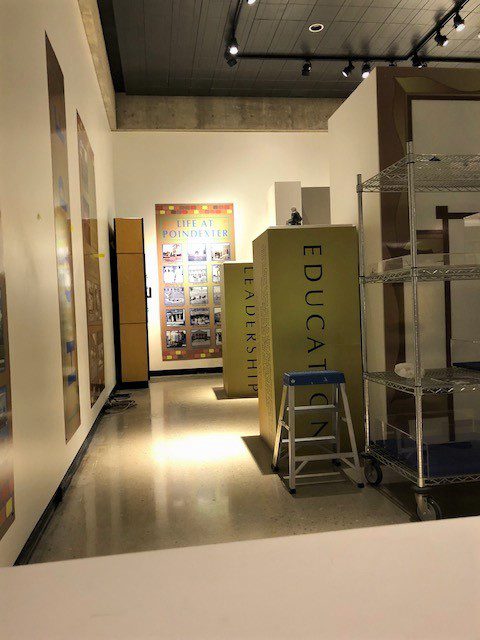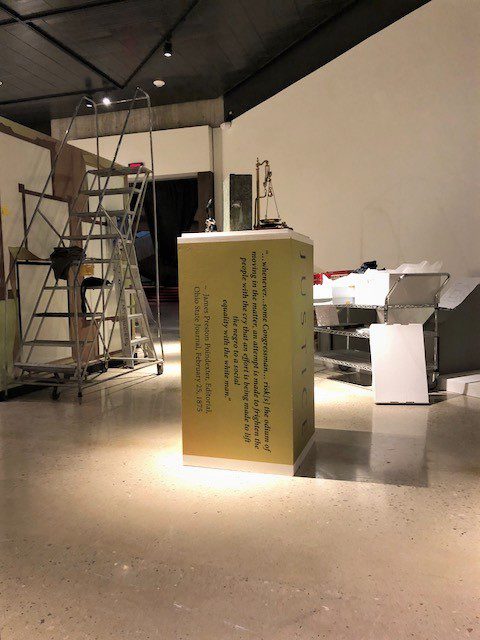Preparing for Poindexter: A New Exhibit at the Ohio History Center
By Kieran Robertson
If you are a regular reader of our History Blog, you may have noticed that I have not been posting very much lately.
So where exactly have I been? Don’t worry, I have not retired from blog writing (you can’t get rid of me that easily). I’ve been working on a very exciting project that I can’t wait to share with you! For the past few months, OHC and the James Preston Poindexter Foundation have been preparing the newest exhibit at the Ohio History Center (drumroll please) – Poindexter Village: A Portrait in Stories.
Now you might be asking, what exactly is Poindexter Village? You will have to visit the exhibit to get the full history, but here’s a little summary of what you might learn about:
During the first wave of the Great Migration during the 1910s, African American residents of the South flooded North looking to escape racial violence and embrace better job opportunities above the Mason Dixon Line. Many of these migrants came to Columbus and settled in the already established African American neighborhood on the East Side.
As the population boomed, housing ran short. In 1939, thanks to President Franklin Roosevelt’s New Deal, Poindexter Village was built as one the first public housing options in Ohio. This allowed residents of crowded neighborhoods to find affordable and healthy housing during the Great Depression. Poindexter Village was filled with small row homes, a recreation center, and only a short walk from the neighborhood middle school. Here residents built a strong community based on the values of Reverend James Preston Poindexter, a historic leader in Columbus.

Construction of Poindexter Village, c. 1939.
A lot of work goes into a museum exhibit, and that’s why I haven’t been posting lately. Opening an exhibit is a huge team effort. Here are just a few of the things that have to happen when an exhibit opens:
- Object Selection. Someone has to choose every single object that you see in an exhibit. Then each object must be tracked, so that we know where to put it away when the exhibit is over, and so we can make sure it isn’t damaged by being on exhibit too long. Sometimes, objects come to museum exhibits through loans from other museums or private collectors. This requires a lot of preparation and paperwork.
- Script Writing. Often the text of an exhibit is called the script, or the narrative. A lot research and time goes into preparing every single word that you will read on the walls of an exhibit. A curator has to take a complicated topic and try to explain it in only a few sentences. Lucky for us, Poindexter Village: A Portrait in Stories, is actually more of a traveling exhibit. It was already on display at the Columbus Historical Society before it came here. Much of the text was already written, edited, and printed on panels that were moved to the Ohio History Connection. However we have added lots of new items from the Ohio History Connection’s collections- and each of these items needed some text.
- Exhibit Layout. So okay, we’ve got some objects and we’ve written some words about them, but what’s next? The objects have to go somewhere. At this point a floor plan is drafted, redrafted, and eventually finalized. Did you know that the way exhibits are organized can have a huge impact on the way you perceive the information? What if an exhibit is organized chronologically and you accidentally go backwards? There are ways to lay out a room that will prevent that.

You can see a binder open to the exhibit floor plan as we work on getting every object in its place in the gallery. (Note: this table is not a museum object, it’s what we call an education object. That means you can touch it, and we can put our paperwork on it.)
- Graphic Design. Once all the text is written and ready to be printed, someone has to design the panels that the text is printed on. This includes managing color schemes, fonts, and reproducing photographs.
- Installation. This is the phase our exhibit is at now! All of the objects need to be put in cases (with very specific mounts that help keep them safe). All of the panels need to be hung, sometimes walls are painted, and the lights are adjusted.
- Opening Day. You don’t want to put all that work into an exhibit and then have no one show up. Our team has also been hard at work planning exciting opening events, and working on getting the word out about the exhibit! On opening day (February 10) you will be able to hear from John Williams, a resident of the Near East Side and a member of the Poindexter family.
If you’re in Columbus, come check out Poindexter Village: A Portrait in Stories between February 10 and September 2, 2018. I promise you won’t regret it!
 Construction of Poindexter Village, c. 1939.
Construction of Poindexter Village, c. 1939.
 You can see a binder open to the exhibit floor plan as we work on getting every object in its place in the gallery. (Note: this table is not a museum object, it’s what we call an education object. That means you can touch it, and we can put our paperwork on it.)
You can see a binder open to the exhibit floor plan as we work on getting every object in its place in the gallery. (Note: this table is not a museum object, it’s what we call an education object. That means you can touch it, and we can put our paperwork on it.)
